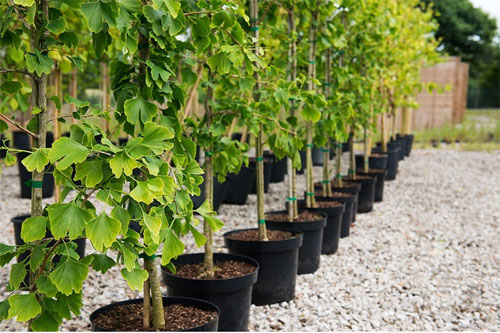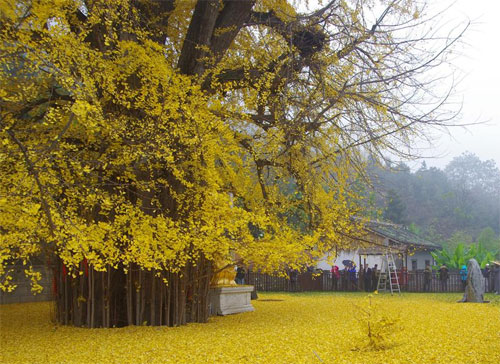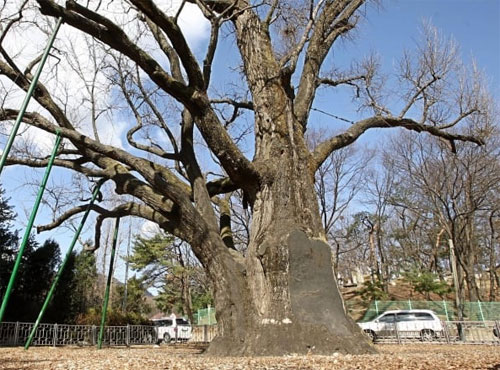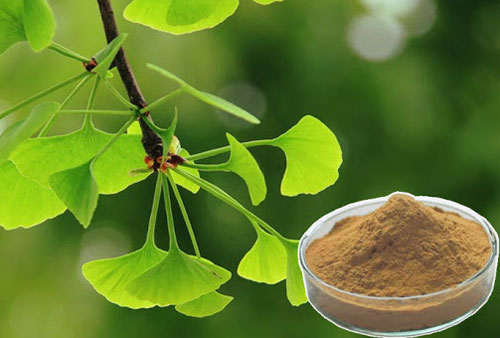The mystery of ginkgo biloba
The ginkgo biloba tree, native to Asia, particularly China, Korea and Japan, has many benefits when used as a supplement. Some of its most impressive actions are associated with brain and memory function, but studies have also indicated that ginkgo biloba can reduce symptoms of anxiety, improve glaucoma (through its antioxidant and vascular effects) and improve blood flow in conditions like Raynaud’s syndrome and erectile dysfunction.

Some of ginkgo’s positive actions may result from the way it increases adenosine triphosphate (ATP), your body’s main source of energy at the cellular level. “This activity has been shown to boost the brain’s metabolism of glucose for energy and to increase its electrical activity,” according to Nutrition Review.
The ginkgo biloba tree has received additional attention for its amazing longevity and resistance to aging as normally seen in animals and many plants. The findings about the ginkgo biloba tree’s remarkable survival qualities may also shed light on the mechanisms behind human results seen from supplementation with ginkgo.
A Tree That Is a Living Fossil
The ginkgo biloba tree, also sometimes called the maidenhair tree, is the world’s oldest living tree and has been referred to as a living fossil. Some living ginkgo trees in China today are said to be 2,500 years old, with one reputed to be 3,000 years old.
Ginkgo has survived, unchanged, through the Triassic, Jurassic and Cretaceous epochs when dinosaurs roamed and became extinct and even through the atomic bombing of Hiroshima and the great fire that occurred after the 1923 Tokyo earthquake. Here is how the Oregon Department of Forestry described the phenomenon:
“Four ginkgos in Hiroshima, Japan, withstood the atomic bombs at the end of World War II – thriving, even blooming — while everything about them was devastated in the blast.
Ginkgos are also believed to provide protection against fire; the bark and leaves are thought to secrete a fire-retardant sap. Many of these trees survived the great fire after the 1923 Tokyo earthquake — and a temple that was surrounded by ginkgos made it through the massive blaze unscathed.”
Clearly, the ginkgo biloba tree has amazing resilience and today thrives in polluted environments like urban roadsides and large modern cities, which seem like nothing compared with surviving the dinosaur age and the atomic bomb.
The name ginkgo derives from the Japanese words “gin” and “kyo,” which mean “silver” and “apricot” respectively and refer to the ginkgo’s apricot-looking fruit. It is the only surviving species from the Ginkgoaceae family.
What Explains Ginkgo Biloba’s Longevity?
Like humans, trees have immune systems. But unlike human immune systems, which begin to degenerate with age, the immune system in ginkgo trees “even though they’re 1,000 years old, looks like that of a 20-year- old,” Richard Dixon, a biologist at the University of North Texas, told The New York Times.

In a paper published in the Proceedings of the National Academy of Sciences (PNAS), Dixon and his co-authors found that the genes in ginkgo’s vascular cambium (the living cells behind its bark) contain no provision for death or senescence.
Instead, write the researchers, genes in the vascular cambium continue to resist disease and supply “preformed protective secondary metabolites” as if the tree were young.
“Transcriptomic analysis indicates that the vascular cambium of the oldest trees, although undergoing less xylem [plant vascular tissue] generation, exhibits no evidence of senescence; rather, extensive expression of genes associated with preformed and inducible defenses likely contributes to the remarkable longevity of this species …
We propose that continuous growth of the cambial cells may enable G. biloba to escape senescence at the whole-plant level …
The ratio of heartwood/sapwood increased with age in G. biloba, and the expression of monolignol and flavonoid/stilbene pathway genes was not significantly reduced in old trees. Thus, accumulated protective specialized metabolites from continuous growth may enhance the resistance of long-lived old trees to adapt themselves to different environments.”
How Do the Cambium Genes Perform?
How, specifically do the genes found in the vascular cambium protect the ginkgo? The researchers write:
“Phenylcoumaran benzylic ether reductase (PCBER) is a major protein component of xylem, where it provides protection by reducing phenolic dimers to yield antioxidant molecules. Notably, of the two PCBER homologs in the G. biloba genome, only one was strongly expressed in vascular cambium.”
Flavonoids could also be at play, they write:
“Flavonoids are a major class of plant secondary metabolites which can protect against both biotic and abiotic stresses. In our dataset, 41 genes were annotated as key genes encoding enzymes associated with flavonoid biosynthesis, including chalcone and stilbene synthases.”
The ginkgo genome is huge and contains 10.6 billion DNA “letters” compared with the human genome that contains 3 billion letters.
The ability to defend against stresses is a major contributor to the ginkgo’s long life, the researchers conclude. In fact, old male ginkgo trees still produce viable pollen and older females still produce a large number of seeds; in both cases, they resemble younger trees.
Ginkgo Bilobas May Not Age but Can Still Die

Peter Brown, director of Rocky Mountain Tree-Ring Research, concurs with the PNAS authors about ginkgo’s mechanisms for not aging and takes the scientific thinking a step further: He ventures that ginkgo trees and others like them could theoretically live forever.
What kills long-lived trees like ginkgo, he says, is not their advanced age but a specific threat to them such as a drought, insect infestations or pests, or urban development:
“Being modular organisms, every year they’re putting on new wood, new roots, new leaves, new sex organs… They’re not like an animal, like us. Once we’re born, all of our parts are there, and at a certain point they just start to give out on us.”
In fact, if a tree’s cambium is intact, it can still live as a hollow stump, producing leaves and flowers. If stumps lack leaves for photosynthesis, they can also obtain water through shared root systems with neighboring trees, scientists have found. Summarizing ginkgo’s longevity, the PNAS researchers write:
“Aging occurs in most multicellular organisms, and in yeast and animal cells is frequently accompanied by telomere attrition, epigenetic alterations, loss of proteostasis, and somatic mutations. However, in plants, aging is complex and multifactorial and is regulated by both genetic and environmental factors.
Aging is associated with deterioration of growth and differentiation as well as with maturity, whereas senescence, which ends in death, is the last developmental stage.
… Due to the complex life cycles of plants, evolutionary theories of aging have somewhat been neglected in the plant kingdom, and thus the mechanisms underlying aging at the whole-plant level remain enigmatic.”
Now, these remarkable mechanisms of ginkgo are being uncovered.
Ginkgo Biloba Offers Many Benefits
Ginkgo biloba is a top-selling extract and dietary supplement with varied and impressive benefits. In addition to the cognitive and memory-boosting properties suggested by studies, here are other actions of ginkgo biloba revealed by studies.

Inhibition of platelet-activating factor — This factor prevents blood coagulation and keeps plaque from forming inside the arterial walls.
Enhances nitric oxide (NO) production in vessels — This promotes healthy endothelial function and subsequent positive effects on peripheral and cerebral blood.
Initiates synaptosomal uptake of dopamine — These actions improve cognitive function and 5-hydroxytryptamine (serotonin), a neurotransmitter known for mobilizing your brain and body for action, linked to positive effects on cognition and attention.
Modulates different neurotransmitter systems — These actions include inhibiting monoamine oxidase A, an enzyme that can affect norepinephrine, serotonin and dopamine in your brain.
Exerts free radical-scavenging activity — Ginkgo has neuroprotective and antiapoptotic properties, such as inhibiting amyloid-β neurotoxicity and protecting against hypoxic challenges. It may be particularly beneficial for treatment of Alzheimer’s disease.
Treats chilblains and small blood vessel dysfunction — Ginkgo has positive effects on inflammation from cold exposure; benefits may extend to Raynaud’s syndrome.
Helps with pathogenic skin microbes — These microbial conditions can include acne vulgaris, blepharitis, dandruff, psoriasis and conditions caused by Staphylococcus aureus.
May help in multiple sclerosis treatment — Ginkgo exerted modest beneficial effects on fatigue and other functional measures in those with multiple sclerosis, in one study.
Ginkgo Reduced Aluminum Levels in Rats
In a 2005 study in the journal Life Sciences, researchers found that ginkgo biloba extract (GbE) exerted a protective effect on memory and learning function in rats treated with aluminum, a metal suspected in the development of Alzheimer’s disease. Here is what the researchers reported after administering aluminum to rats:
“Aluminum administration significantly increased escape latency and searching distance, indicative of brain dysfunction. GbE treatment significantly protected against aluminum-induced brain dysfunction, as evidenced by decreased escape latency and searching distance compared with the Al [aluminum] alone group …
In summary, this study demonstrates that GbE is effective in improving the ability of spatial learning and memory of aluminum-intoxicated rats. This protection appears to be due to a decreased expression of APP [amyloid precursor protein] and caspase-3 in rat brain, resulting in a decrease in the production of insoluble fragments of Abeta-amyloid.”
A Few Cautions About Ginkgo Biloba
While ginkgo may offer neuroprotective, metabolic and immunological benefits, some people have experienced mild upset stomach or headaches after taking ginkgo supplements, a sign that ginkgo may not be right for you. With larger doses, sensitive individuals may experience episodes of dizziness, diarrhea and nausea.
Women who are pregnant and breastfeeding should not take ginkgo nor should people with epilepsy use the supplement because it may cause seizures. Also, people susceptible to poison ivy and similar plants should avoid ginkgo because of the allergic potential of its leaves’ long-chain alkylphenols.
If you are older, pregnant or have a known bleeding risk, an increased risk of bleeding is possible with ginkgo. Do not take ginkgo if you are currently on a blood-thinner medication because of interactions. For similar reasons, do not take ginkgo before undergoing surgery or dental procedures.
Also, do not eat raw or roasted ginkgo seeds, because they can cause serious side effects and may be poisonous. With these cautions, you can enjoy the benefits from this tree that has an amazing ability to live practically forever.
yogaesoteric
September 15, 2020
Also available in:
 Français
Français
